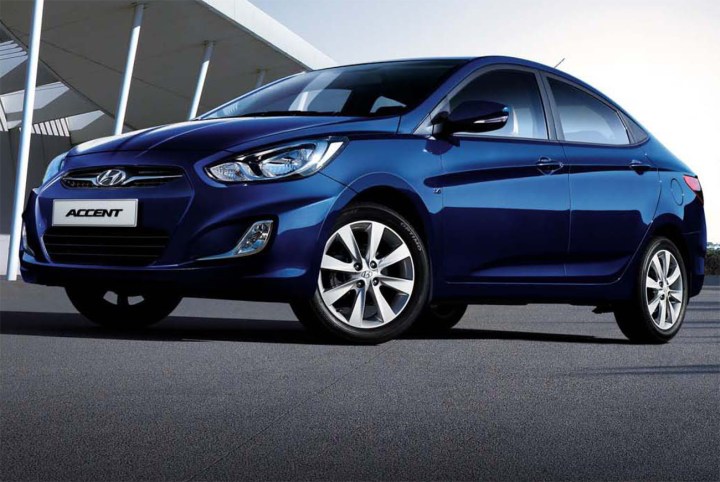Sci-Tech
Hyundai Accent 1.6 GLS: An unexpected hero

Almost four decades ago, a fledgling automaker called Hyundai produced a modest compact sedan dubbed the Pony. It was small and pokey, with ugly duckling looks, a tacky interior and a flimsy execution. Thirty-six years later, its bloodline is altogether more convincing– proof the Korean auto industry has come a long way. DEON SCHOEMAN drives the latest Hyundai Accent.
The new Hyundai Accent, launched in South Africa late last year, is an unexpectedly sleek and sexy compact sedan that expresses the brand’s trademark, so-called fluidic design language with aplomb.
It finds itself in one of the most popular and most competitive segments of the new car market, taking on established players such as the VW Polo Sedan, the Ford Fiesta sedan and the Chevrolet Aveo.
Against a backdrop of rising running costs and fuel prices, the increasing popularity of smaller cars comes as no surprise. But the buyer’s expectations have also increased: anyone spending R150,000-plus on a car has every right to demand more than just wheels and an engine.
For that kind of money, we also want comfort, safety and (hopefully) a touch of style. The Accent’s appeal lies in its ability to tick more boxes than most.
As pragmatic as we’d like to be, the emotive appeal of a car is greatly enhanced by attractive styling – and that’s the Accent’s first achievement. It mirrors the fluid design language already expressed by the larger Sonata and Elantra, but its more compact execution means it’s the best-looking sedan in the Hyundai stable.
The shape is overtly aerodynamic, with a sweeping roofline that‘s more coupé than sedan and proportions that express both style and dynamic appeal.
Also, like all latest-generation Hyundais, the Accent isn’t embarrassed about flaunting its identity: the front-end treatment is boldly, unequivocally Hyundai. The slim, chrome-trimmed grille is partnered by a more aggressive lower air intake, while large headlights add to the car’s expressive face.

In profile, the wedged shape of the Accent becomes apparent, emphasised by a strong shoulder line and the short, high rear deck. A short front overhang, and pronounced wheel arches add further appeal.
The rear execution is compact and tidy, dominated by the geometric shapes of the tail lights, the generous bumper and the deep rear apron.
Most of all, the Accent’s proportions are just right – except for the wheels, which look too small for the apertures. Besides, the Accent deserves alloys, instead of the steel wheels with tacky hubcaps.
The Accent’s cabin is as appealing as the exterior styling. Given that it competes in the subcompact segment, the interior looks and feels spacious, with a nice mix of textures and colours, and finishes that create a smart impression.
On closer inspection, some of that beauty is just skin deep. The velour upholstery passes muster readily enough, but the textured plastic used for the dashboard surfaces remains hard to touch and the fake aluminium accents don’t convince.
That said, the sculpted door panels cleverly create more space, and the sweeping dashboard’s contours are pleasing on the eye. Ergonomics are good too, with a decent driving position, good overall visibility and plenty of adjustment scope.
The standard specification is impressive too – the top-range GLS version under scrutiny here has just about everything that opens and shuts: air-conditioning, remote central locking, an integrated sound system with Bluetooth and USB connectivity, electrically operated windows and mirrors, a trip computer and a multifunction steering wheel with audio and cruise control buttons.
For a car in this category, rear accommodation is comfortable, with adequate space for two adults. And the boot is a revelation, swallowing 389-litres of luggage. The rear seat back is split 60/40 and can be folded down to boost cargo space. The only downside here is a loading sill that’s quite high.
This latest Accent is offered with one engine derivative only. It’s Hyundai’s own, latest-generation Gamma four-cylinder unit, offered here in 1,600cc form. The all-aluminium unit is fitted with electronic fuel injection, twin overhead cams and variable valve timing.
Maximum power comes to 91kW at 6,300rpm, combined with a 156Nm torque peak at 4,200rpm.
Predictably, power is delivered to the front wheels,and there’s a choice of five-speed manual or four-speed automatic gearboxes.
Given the Accent’s trim 1,050kg kerb mass, the power-to-weight ratio is a useful 87kW/ton, which suggests sprightly performance, despite a power delivery that, on paper at least, appears to be on the peaky side.

Fortunately, the reality proves otherwise. On the move, the Accent feels peppy and eager from the word go, with good throttle response and a pleasantly raspy exhaust note. It’s a sporty demeanour that takes one by surprise and will certainly please younger buyers.
The result is a car that feels swift and responsive. There’s plenty of low-down oomph, despite the peaky torque maximum, and in-gear tractability is good too. Besides, the five-speed gearbox has smooth, unfussed shift action, so that making full use of the gearbox only adds to the overall experience.
As a result, the Accent feels faster and friskier than it really is. Hyundai’s sea-level performance figures credit the compact sedan with a zero-to-100km/h acceleration time of 10.2sec, and a top speed of 190km/h.
At the same time, the combination of low weight and wind-cheating aerodynamics allow a combined cycle fuel consumption figure of just 6.1-litres/100 km – and an even more impressive 5.0/100km on the open road.
Frankly, those claims are a little off the mark for those of us who enjoy driving a peppy car like the Accent with some enthusiasm. But even then, an average figure of seven-litres is entirely feasible, as is a sub-six figure at constant, legal highway speeds.
Importantly, the Hyundai’s straight-line urge is coupled to decent road manners and good braking capability. The suspension is a conventional combination of front MacPherson struts and a torsion beam rear axle, but the ride is smooth without becoming soggy, and there’s enough feedback to create a good rapport between car and driver.
The steering is electrically assisted, which always introduces an element of remoteness, but turn-in is crisp enough, and there’s enough feedback to allow for confident cornering. An all-disc braking system with ABS and EBD makes slowing down the Accent a fuss-free affair too.
Road noise is disappointing at highway speeds though, and the engine can become a little raucous approaching the red line. But then, this isn’t a premium sedan!
I’ve said it before: Korean cars have come of age and the Accent is another convincing example. It proves that excellence and affordability don’t have to be mutually exclusive and the result is a compact sedan offering compelling value.
But perhaps the Accent’s greatest achievement is that it isn’t just a good buy in rational terms – it’s attractive on an emotive level too. Which is why its rivals from Japan and Europe must be quaking in their boots. DM







 Become an Insider
Become an Insider